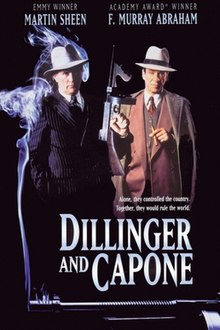Dillinger and Capone
| Dillinger and Capone | |
|---|---|
 Theatrical release poster | |
| Directed by | Jon Purdy[1] |
| Written by | Michael B. Druxman |
| Produced by | Roger Corman[2][3] Mike Elliott |
| Starring |
|
| Cinematography | John B. Aronson |
| Edited by | Norman Buckley |
| Music by | Steve Cohn |
Production companies | New Horizons Hillwood Entertainment Production |
Release date |
|
Running time | 95 minutes[4] |
| Country | United States |
| Language | English |
Dillinger and Capone is a 1995 American action film directed by Jon Purdy[5] and starring Martin Sheen, F. Murray Abraham, Michael Oliver, Catherine Hicks, and Don Stroud.[6][4] The film was screened at MystFest in Cattolica, Italy and the Cannes Film Festival in 1995.[2][7] Written by Michael B. Druxman, the film is not based in real events but imagines a world in which John Dillinger is not killed at the Biograph Theater and lives on to work with Al Capone. The film was acquired by Cinemax and aired on their cable television network periodically in 1996.[8][9] In 1997 the film was acquired by HBO and aired periodically on that television network.[10][11]
Plot
[edit]On July 22, 1934, George is shot and runs to John Dillinger’s door. George calls out to John but when the door is answered, it turns out to be his brother Roy who answers. Roy tells George that John is at the movies, George tells Roy to tell John about the setup about the guards trying to killing him in the theater.
Roy runs to the Biograph Theater but Perkins shoots Roy to death thinking he's John.
John Dillinger hears the gunshots and goes inside the theater to see his brothers dead body on the floor. The authorities believe that they have killed Dillinger, and he decides to take advantage of the mistake and retire with anonymity.
Al Capone walks out of the front door of jail and bumps into two reporters trying to talk to him about how it is forgotten that he was the king of Chicago.
Cecil drives Al Capone in taxi to take him to Chicago. Capone learns Dillinger is alive, and uses this information to coerce Dillinger into committing a heist for the mob.
Cast
[edit]- Martin Sheen as John Dillinger
- F. Murray Abraham as Al Capone
- Michael Oliver as Sam Dalton
- Catherine Hicks as Abigail
- Don Stroud as George
- Stephen Davies as Cecil
- Michael C. Gwynne as Perkins
- Jeffrey Combs as Gilroy
- Anthony Crivello as Lou Gazzo
- Clint Howard as Bobo
- Time Winters as Eli
- Jeffrey Dean Morgan as Jack Bennett
Critical reception
[edit]An Entertainment Weekly review in 1995 gave the film a "C minus" rating and described it as "far-fetched fiction".[6] Critic Leonard Maltin awarded the film two stars, and stated that the film is "boosted by slick acting, but it soon slides into a routine heist thriller."[12]
References
[edit]- ^ "Jon Purdy - Filmography". British Film Institute. Archived from the original on September 13, 2021. Retrieved 13 September 2021.
- ^ a b "News: FESTIVALS - MYSTFEST". Screen International (1013): 6. June 23, 1995.
- ^ John McCarty (2009). Bullets Over Hollywood: The American Gangster Picture From The Silents To "The Sopranos". Hachette Books. ISBN 9780786738755.
- ^ a b "Dillinger and Capone". TV Guide. Retrieved September 13, 2021.
- ^ "Dillinger and Capone". Letterboxd. Retrieved September 13, 2021.
- ^ a b Michael Sauter (August 18, 1995). "Dillinger and Capone". Entertainment Weekly. Retrieved 8 November 2021.
- ^ "Spotlight: CANNES". Variety. 359 (3): C72. May 15, 1995.
- ^ "Cinemax: Dillinger and Capone". The Washington Post. 31 March 1996. p. MC65.
- ^ "Late Movies; Dillinger and Capone". The New York Times. 8 April 1996. p. C15.
- ^ "Home Box Office; Dillinger and Capone". The Washington Post. 27 April 1997. p. BR71.
- ^ "Home Box Office; Dillinger and Capone". The Washington Post. 28 September 1997. p. H_AA72.
- ^ Leonard Maltin (2014). Leonard Maltin's 2015 Movie Guide. Penguin Publishing Group. ISBN 9780698183612.
